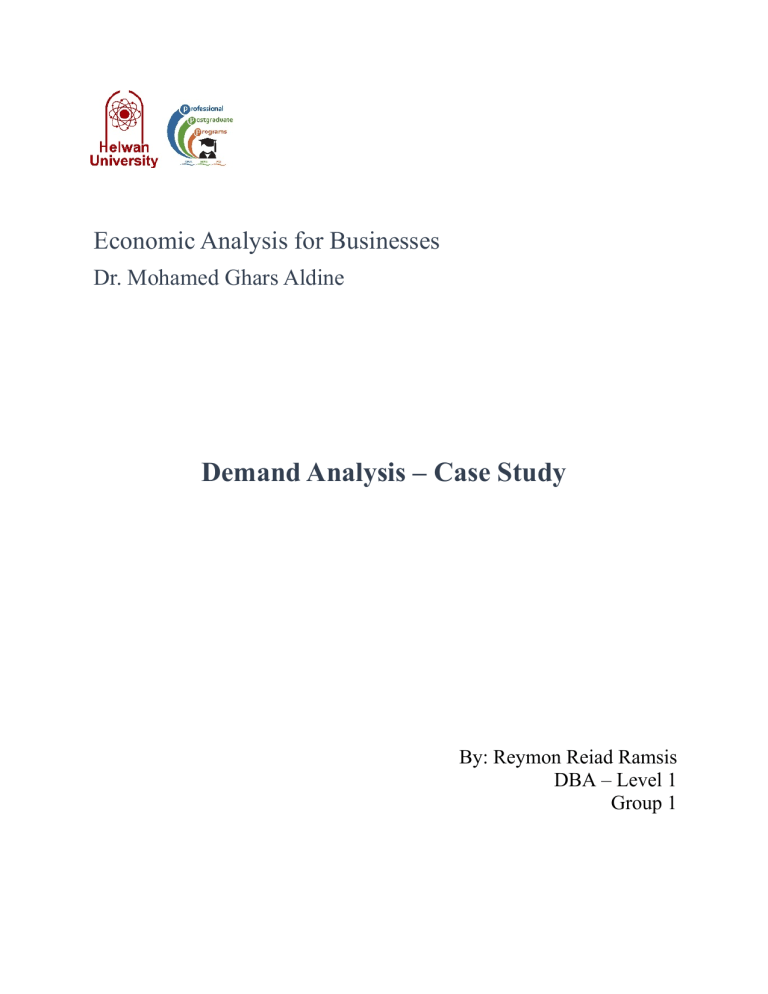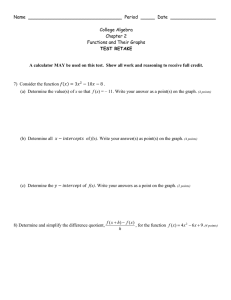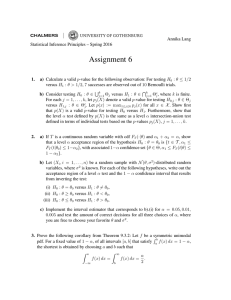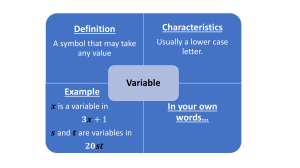
Economic Analysis for Businesses Dr. Mohamed Ghars Aldine Demand Analysis – Case Study By: Reymon Reiad Ramsis DBA – Level 1 Group 1 Economic Analysis for business Demand Analysis – Case Study Demand Analysis – Case Study I used the given data for X Corporation to estimate the best fit demand equation on the basis of the 48 data observations (eight quarters of data for each of six areas) in two different ways. a. Regression statistics for each given dependent variable individually. b. Multiple Regression statistics for all variables together Below will show the result of both ways with a description of the outputs. a. Regression statistics for each given dependent variable Table (1) summarizes the result for each demand function describing: 1. Q equation (each variable as predictor) 2. R2 for each demand function 3. P-value 4. The coefficient for each independent variable to indicates the marginal relation between that variable and Quantity of unit sold Dependent Variable Equation R Square P-value Price ($) Advertising Expenditures ($) Q = 936734 - 80871 P 10.0% 0.029 Q =157587 + 8.02 Ad 35.0% 0.000 Competitors Price ($) Q = 166908 + 36918 Px Q = - 242841 + 12.0 Inc Q = 1.15 + 0.65 Pop 2.7% 0.268 12.3% 53.7% 0.015 0.000 Income ($) Population Table (1) (R Square, P-Value, and coefficient) description Form the analysis we can say that the highest R2 value are for the demand functions respectively are: 1. Population: (Q = 1.15 + 0.65 Pop) R seq (53.7 %) – P (0.00) R seq (53.7%) means this equation explain 53.7 % of changes is demand. With Pvalue = 0 (strongly reject H0) which means that the population is strongly significant affect the Quantity of unit sold. Page 1 of 4 Economic Analysis for business Demand Analysis – Case Study Explanation (If Population increased by 100 pax the Q will increase by 65 unit) 2. Advertising Expenditures ($) (Q =157587 + 8.02 Ad ) R seq (35 %) – P (0.00) In this Model R seq (35%) which means that is not enough to explain the change of Q as it’s only explained 35% of variation (explained variation / Total variation = 35%) P-value = 0.00 which means there is strong significant relationship between change in Q and amount of Advertising expenditures. Explanation (If the amount of Advertising expenditures increased by 1 $ the quantity of unit sold will increase by 8 units) Conclusion: From the analysis, all previous models fail to explain the demand function by more than 70% (as the highest R seq = 53.7%) even if there are strong significant relationship between the Q and some of the variables (Population, Price ($), Advertising Expenditures ($), income) according to P-values b. Multiple Regression statistics for all variables together Demand function for all variables together is: Q = 529774 – 122607 P + 5.84 Ad + 29867 Px + 2.04 Inc + 0.0303 Pop + 2815 T R sq = 87.1% P-Value = 0.000 Conclusion: (R sq = 87.1%) That means the regression model explain 87.1% of the total variation in demand. This is a very satisfactory level of explanation for this equation so it can explain and predict better that all previous models. 87.1% of the variation in Quantity sold is explained by these dependent variables together (Price, Advertising Expenditures, Competitors Price, Income, Population, and time) Page 2 of 4 Economic Analysis for business Demand Analysis – Case Study On other words the equation fit by 87.1% which is the best equation could explain the demand function in the light of the given data. P-Value = 0.000 for all variables together That means all dependent variables together have strong significant mutual effect. So we strongly reject null hypotheses as there is strong relationship between Q and all other dependent variables together. And for more details table (2) explain the P-value for each variable in this model Dependent Variable P-Value Price ($) Advertising Expenditures ($) Competitors Price ($) Income ($) Population Time 0.000 0.001 0.032 0.590 0.000 0.539 Table (2) The analysis of the data shows that (Price, Advertising Expenditures, Population, Competitors Price) all of them are strongly significant affect the Q with P-value less than 0.05) while the income and time with P-value greater than 0.5. which means these variables (Price, Advertising Expenditures, Population, Competitors Price) affect the Q more than other variables. Explanation The coefficient The coefficient for each independent variable indicates the marginal relationship between that dependent variable and Q, (holding other variables constant in the demand function). Individual coefficients provide useful estimates of the expected marginal influence on demand following a one-unit change in each one of the variables. For example, coefficient for P is (-122607) which means If Price increased by 1$ the demand will decrease by 122607units (holding other variables constant) Page 3 of 4 Economic Analysis for business Demand Analysis – Case Study coefficient for Ad is (5.84) which means If Advertising Expenditures increased by 100$ the demand will increase by 584 units (holding other variables constant) coefficient for Px is (29867) which means If Price of Competitors increased by 1$ the demand will increase by 29867 units (holding other variables constant) coefficient for P is (-122607) which means If Price increased by 1$ the demand will decrease by 122607units (holding other variables constant) coefficient for P is (-122607) which means If Price increased by 1$ the demand will decrease by 122607units (holding other variables constant) Page 4 of 4



